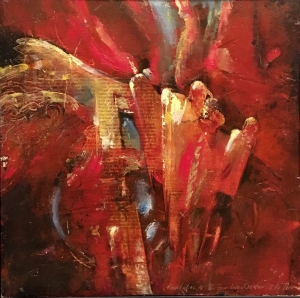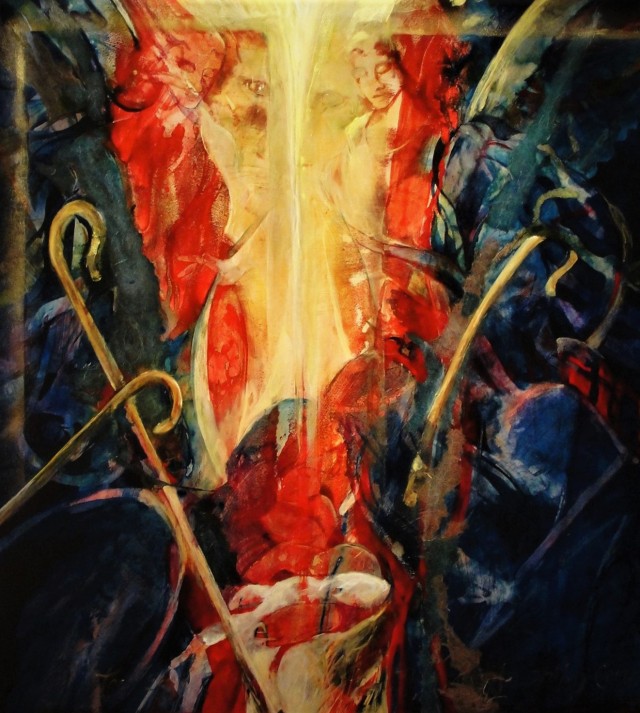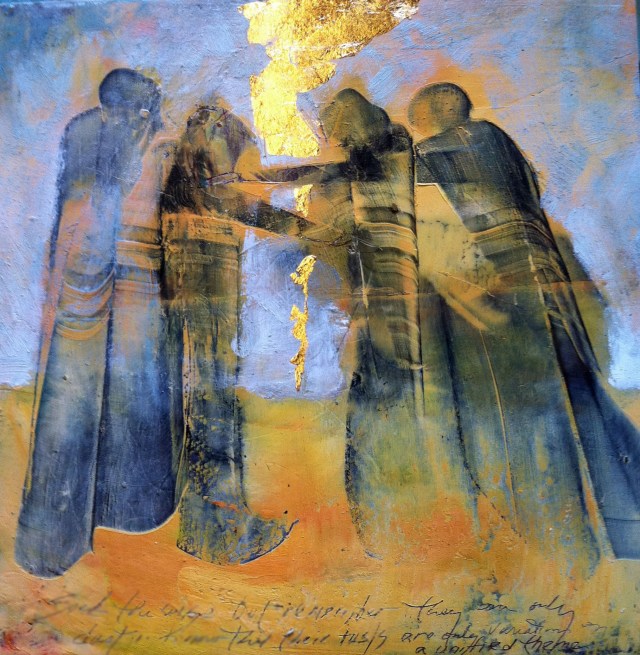Advent Celebration
The Account of Christ’s birth
My painting Variations on a Theme / The Four Evangelists (12 x 12) seems a fitting image to reference the four gospel accounts of the birth and life and death of Christ Jesus – Emmanuel – God With Us. Matthew, Mark, Luke and John each present a uniquely inspired picture of Jesus’ birth and life. Take time to read them.
Matthew’s gospel is to the Jewish people and presents the authority of Jesus as The King of the Jews, The Lion of Judah. He begins with the historical records, “The record of the genealogy of the Messiah . . . “
Mark’s gospel presents Jesus as the Lord who serves and proclaims with immediacy the good news of this miracle-working Savior who comes to be a sacrifice. He begins, “The beginning of the gospel of Jesus Christ, the Son of God.”
Luke, the physician, writes his gospel with precision and detail for the Gentile nations and shows a human Savior, The Savior who brings liberation to the poor and neglected. Dedicating his book to the Greek, Theophilus, he begins, “Inasmuch as many have undertaken to compile an a narrative of the things that have been accomplished among us, just as those who from the beginning were eyewitnesses . . . .”
And John’s gospel presents Jesus as the incarnate God, who created the world and comes in flesh as the Word of God, “who is the true light that enlightens everyone.” He begins, “In the beginning was the Word, and the Word was with God, and the Word was God. He was in the beginning with God . . . .”
The four gospels are variations on the unified theme. They tell us who God is in all his power and glory. Like the four living creatures around the throne of God in the book of Revelation, who proclaim continuously, “Holy, holy, holy is the Lord God Almighty, who was and is and is to come,” the four evangelists share the same “good news!”
In 1614, the painter, Peter Paul Rubens painted The Four Evangelists. It was common in Medieval art to describe the gospel writers using animal characteristics – in reference to Revelation’s vision of God himself in His various attributes by four living creatures. We see a lion lying at Matthew’s feet, Mark rests on the ox, an eagle hovers over John, and a human face like an angel hovers over Luke.
The four figures in Ezekiel’s vision also reference the four living creatures in Revelation. They surround the throne of God and proclaim His glory.
Ezekiel 1:5-14 . . . Within it there were figures resembling four living beings. And this was their appearance: they had human form. Each of them had four faces and four wings. . . as for the form of their faces, each had the face of a man; all four had the face of a lion on the right, and a face of a bull on the left, and all four had the face of an eagle.
Ezekiel’s Vision shows my painting of the four creatures proclaiming glory to God .

The final revelation of Jesus Christ (Revelation 4: 6-11) shows us this glorious God. “And around the throne were four living creatures full of eyes in front and behind. The first creature was like a lion and the second was like a calf, and the third creature had a face like a man, and the fourth creature was like a flying eagle. And the four living creatures each of them having six wings are full of eyes around and within, and day and night they do not cease to say, “HOLY, HOLY, HOLY, IS THE LORD GOD ALMIGHTY WHO WAS AND WHO IS AND WHO IS TO COME.”
The mosaic below is over a thousand years old. It shows Christ with the four creatures around him.


The gospel or good news of Jesus Christ told by four inspired writers is central to salvation. To the right is a Medieval ivory plaque which shows winged evangelists or tellers of good news surrounding The Lamb of God.
Albrecht Durer painted The Four Apostles rather than The Four Evangelists(1526). He painted them for the town hall (not a church) of his hometown of Nuremberg. And instead of three panels, he omitted the prescribed center panel with Christ or Mary. The two panels are larger-than-life-sized portraits of the apostles. He painted John in red in the foreground pointing to the verse in his gospel which reads, “In the beginning was the Word . . . . ” The spread of The Word was important to Durer. He was a contemporary of Guttenberg who had just invented the printing press. Durer illustrated many copies of newly printed Bibles which were finally available to the common man.
May we continue to celebrate the eternal story told in four uniquely and perfectly told narratives by Matthew, Mark, Luke, and John.

The Scepter Shall Not Depart from Judah UNTIL SHILOH COMES 48 x 48 http://gracecarolbomer.com/artwork/2982602_Until_Shiloh_Comes.html
http://www.youtube.com/watch?v=fGJAm1iM1Vc
In Anticipation of Christmas!




where is that mosaic from of the creatures in revelation?